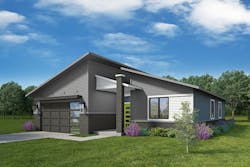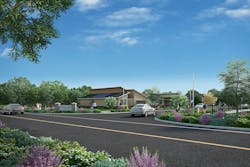Smart Neighborhood Project Combines Net Zero with Natural Gas
Building net zero, carbon neutral homes means going all-electric and getting rid of natural gas entirely—right? Actually, no, according to a new home development and research project launched by Nicor Gas, the largest natural gas provider in Illinois, in partnership with Habitat for Humanity.
The Smart Neighborhood project aims to demonstrate that natural gas can be a part of the energy solutions for net zero, carbon neutral homes. “Our goal is to understand how we can leverage the existing gas system to support the clean energy transition,” says Meena Beyers, vice president of business and community development, Nicor Gas. “What we’re really trying to show is that natural gas is a critical part of the transition toward a clean energy future.”
In the cold-climate northern Illinois region that Nicor Gas services, Beyers says, 75% of the energy that residents use is delivered by natural gas. “We can leverage a reliable, affordable system that’s already in place,” she says. “With this project, we’re looking at how all the energy sources together—gas, electric, renewables, and battery backup—work together to achieve net zero and how we optimize that so it’s the most affordable and resilient path to net zero for a community with extreme weather conditions.”
Nicor Gas Smart Neighborhood Project
The Smart Neighborhood project comprises two communities, both developed and built by Habitat for Humanity, which will use homeowner and volunteer builders to construct 30 affordable homes ranging between 1,600 and 1,800 square feet.
The first development, whose groundbreaking is slated for June, will provide 17 homes in Aurora, a northern suburb of Chicago. “It’s the first of its kind in Illinois where all the homes in the community are net zero, carbon neutral, and affordable,” Beyers says. The first five Aurora homes should be completed by spring 2024. The second community will provide 13 homes in the Northern Fox Valley region outside Chicago; construction is expected to begin early next year.
At the National Renewable Energy Laboratory, Nicor Gas and Habitat for Humanity spent three years modeling and simulating over 20 different home-technology packages. They aimed to identify the net zero, carbon neutral options that are most resilient and affordable for a home’s construction and operations in this region.
The team landed on three different technology packages that Smart Neighborhood will deploy. The first will include high-efficiency gas heating. When modeled, this option was found to be the “most resilient, lowest-cost path to net zero for this location,” Beyers says. The second package will have a hybrid system with both a heat pump and a natural gas furnace backup. And the third will have a heat pump that uses natural gas (“that’s new technology, so it’ll be the final phase to make sure it’s commercially available,” Beyers says).
Nicor Gas will collect and analyze data on the different tech packages and energy sources, and will share its learnings with homebuilders and with Habitat for Humanity to inform future projects.
To achieve the project’s energy goals, the Smart Neighborhood homes will include rooftop solar, Generac’s battery storage systems, and heat recovery ventilation (HRV) systems that improve the homes’ efficiency and indoor air quality. Additionally, the homes will be built with BuildBlock’s insulating concrete form (ICF) walls, which create an efficient building envelope—and are also easy for Habitat for Humanity’s volunteer builders to use, Beyers notes.
“We don’t think that net zero should be out of reach for the average homeowner or low-income communities, so we’re focused on using readily available technologies that are proven and tested,” Beyers says.
The Smart Neighborhood homes also will feature smart home tech and appliances such as smart thermostats and virtual dashboards for customers to manage and monitor their energy usage.
“We know that the clean energy transition will take time and that the existing natural gas service has an important role in that,” Beyers says. “This is a long game in working toward clean energy goals, and we can’t just have the environmental benefit—it has to be affordable and resilient and deliver energy when people need it most.”


